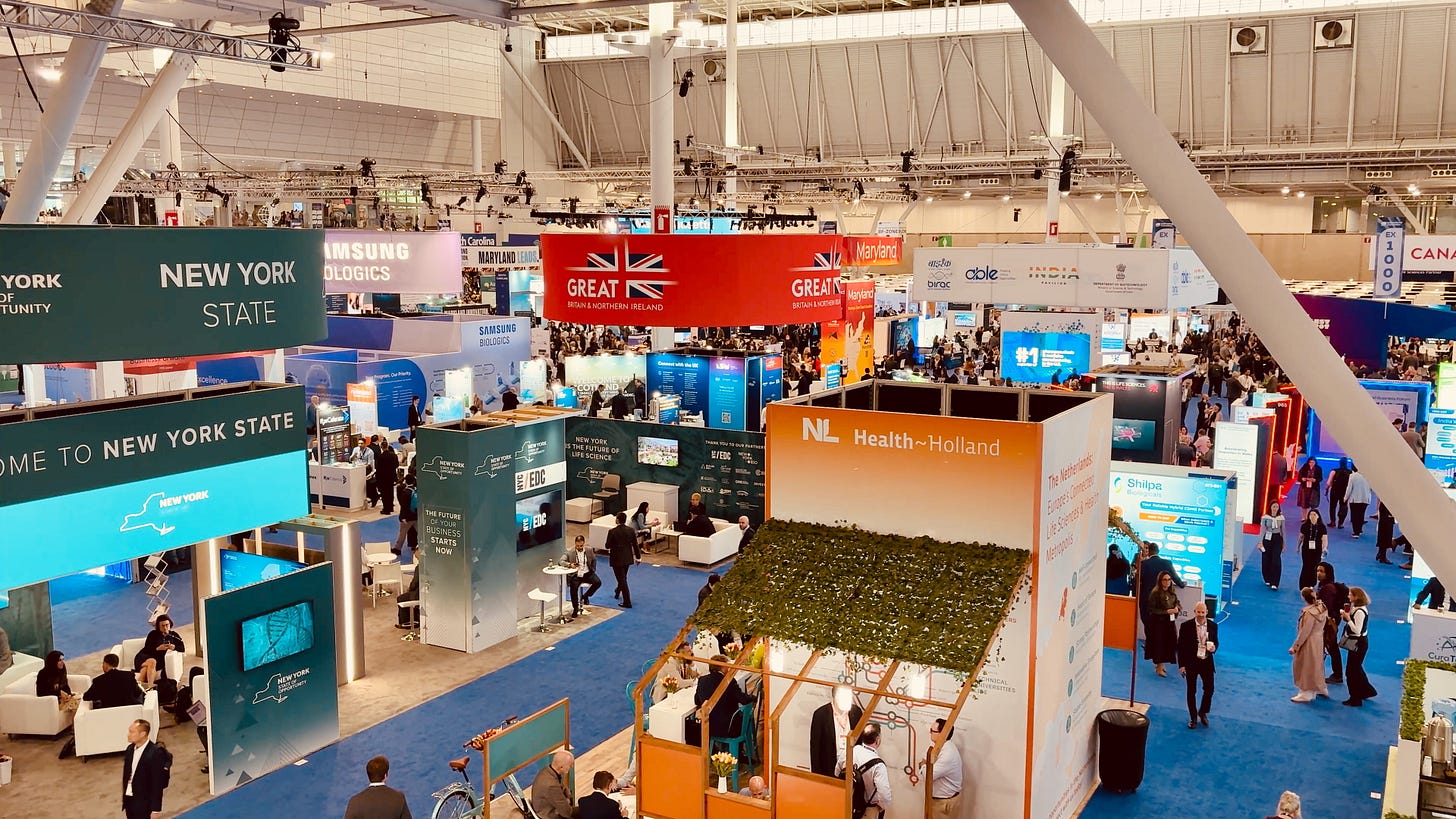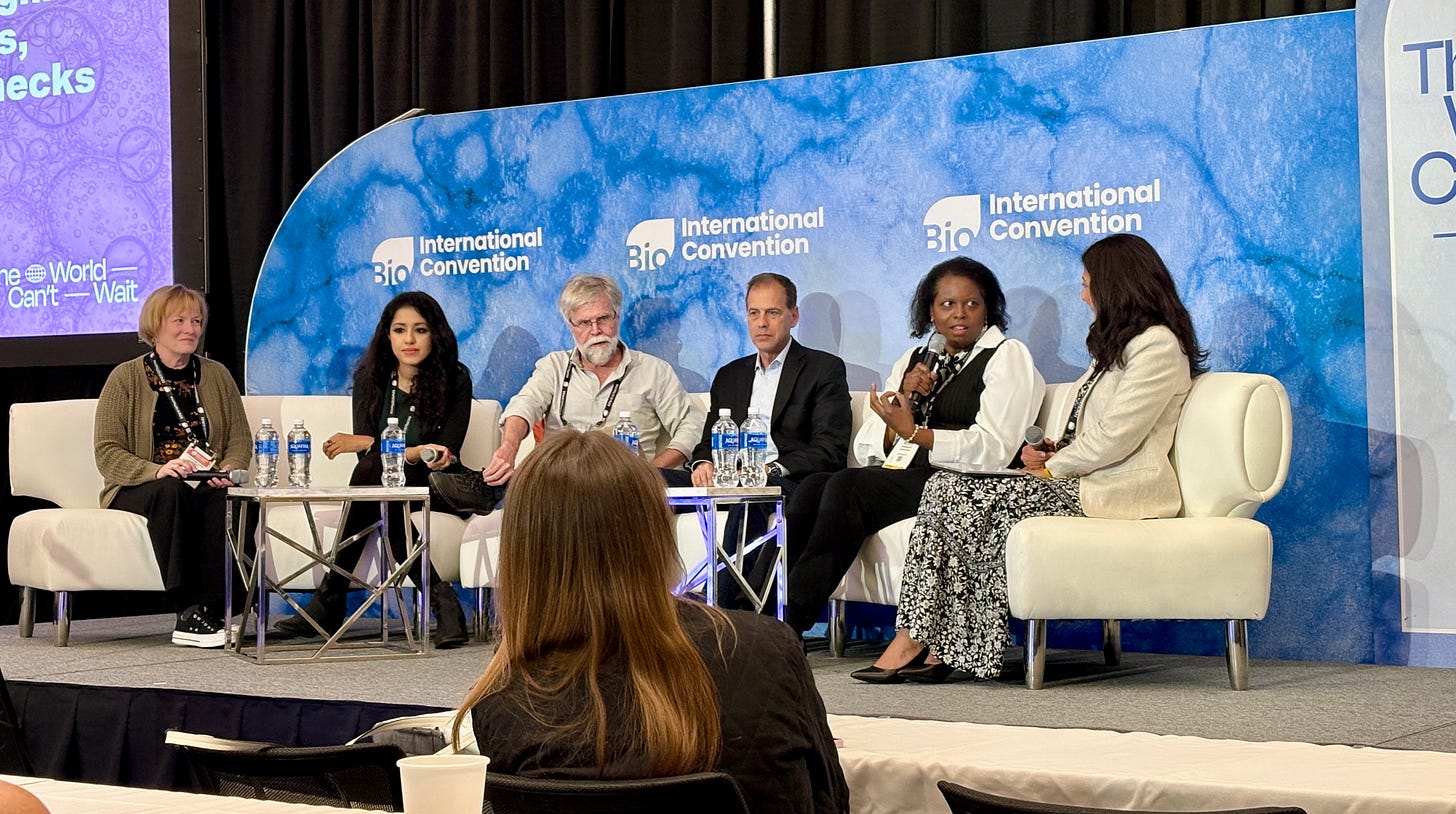BIO International Convention, Virtual Cells, Quantum Architectures, and More
Takeaways from a week at the epicenter of biotech + industry updates
I recently spent a week at the BIO International Convention in Boston, billed as the world’s largest and most comprehensive event for the biotechnology industry, with over 20,000 registrants from more than 70 countries. Through attending small panels, and roaming the cavernous exhibition floor, I learned a ton.
More on that (+ a video walkthrough) in “Deep Dive,” below. But first, some industry updates 👀
DeepMind Introduces AlphaGenome: Mutations in the BRCA1 or BRCA2 genes are associated with a higher incidence of breast cancer. One of the holy grails of genomic research is understanding how the countless other mutations in our DNA influence biological processes and, ultimately, human health. To that end, DeepMind’s new AlphaGenome model takes DNA sequences as long as one million letters and predicts thousands of molecular properties characterizing its regulatory activity.
Arc Institute Introduces The Virtual Cell Challenge: In parallel to DeepMind’s efforts, the Arc Institute is looking to better understand how our cells respond to genetic and chemical perturbations, key to unlocking human health. To do so, the Arc Institute has launched the Virtual Cell Challenge, awarding $175K in prizes to the top models that can predict the effects of perturbing 300 genes.
MIT Researchers Enable Quantum Processors To Talk To Each Other Directly: The combinatorial explosion of developing novel materials, or simulating biological systems, overwhelms even our best “classical” supercomputers quickly. Quantum computers offer a way out, however they’re stubbornly sensitive to perturbations from the external environment. Point-to-point connectivity between quantum processors increases error rates. In support of a more direct (and less error prone) architecture, MIT researchers developed a new interconnect device that can support scalable, “all-to-all” communication, so that all superconducting quantum processors in a network can communicate directly with each other.
AI-powered Engineering Platform PhysicsX Raises $135M Series B: It’s one thing to develop a novel material or technology, it’s another matter to scale up its production. Addressing this challenge head-on, UK-based startup PhysicsX recently raised a large round to develop AI software for advanced manufacturing. Here’s their materials value prop: "By refining component design across production lines — enhancing furnaces, mixing baths, heat exchangers, conveyor belts, and feeders — we drive efficiency and innovation. AI-powered process control maximizes production, minimizes emissions, and reduces maintenance."
During my week at the BIO International Convention, some of the most compelling conversations happened in the smaller, more intimate panels above the convention floor. A few I attended include:
As I reflect on these – and the hallway conversations – a few themes stand out:
AI Beyond Drug Discovery
As AI generates ever-more molecules to test as potential drug candidates, it exacerbates bottlenecks downstream. Several industry leaders described the need to apply AI to the long tail of workflows that follow target or molecule identification, including in manufacturing. For example:
Streamlining paper-based Batch Production Records (BPRs)
Leveraging digital twins to optimize automation and yields
Innovation in a Regulated System
Biotech’s structural hurdles – regulatory complexity, long timelines, capital intensity – remain. But some panelists offered creative workarounds. One neat idea: Hospital systems developing and delivering their own cell and gene therapies in-house. Think “hospital as biotech startup,” vertically integrating development and care. It struck me as a concept right out of Doblin’s Ten Types of Innovation framework – one of my favorites.
Overbuilt Today, Platforms of Tomorrow?
The BIO convention floor was teeming with CDMOs, CROs, and other service providers. I spoke to one who described their rapid scale-up to revenue and profitability during the COVID era, now followed by a sharp drop in demand.
I wonder if there’s a parallel to the dot-com era, when over-investment in broadband infrastructure led some companies to shut down, but ultimately laid the foundation for a new wave of high-tech giants. Could what was overbuilt in the last cycle end up fueling the next?
Watch Now
For an inside peek at the convention, including interviews with those building organs-on-chips and automated liquid biopsies, check out my walk-through and take-aways here:
Featured Orgs & People
BloodScan Biotech (Featuring Eric Lin)
SCHOTT Pharma (Featuring Andrew Crawford, PhD)
Central European BioForum (Featuring Magdalena Kulczycka, PhD)
UK Department for Business and Trade (Featuring Raffaella Harvey)
Choose New Jersey (Featuring Rachel Cohen, MBA)
MEPSGEN (Featuring Ville Kujala)
ReciBioPharm (Featuring Aaron Cowley)
Find this newsletter valuable? Subscribe for regular insights and share it with friends who are passionate about accelerating scientific discovery.
Help us improve. Like a good neural network, this newsletter is only as effective as the input it receives. We’d love to hear your feedback – let us know how we can make it even better for you.
Catch you on the next one 🤙🙌 – Nabil









